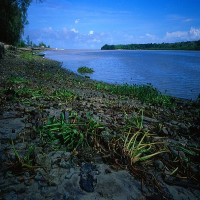 Smart Citations
Smart CitationsSee how this article has been cited at scite.ai
scite shows how a scientific paper has been cited by providing the context of the citation, a classification describing whether it supports, mentions, or contrasts the cited claim, and a label indicating in which section the citation was made.
Diet and isotopic metrics of predatory and prey fish in two estuaries with different degrees of anthropogenic disturbances: the case study of Wami and Pangani rivers in Tanzania
Diverse anthropogenic activities including alteration of hydrological regime and agricultural development in the upstream of the river catchments modify the structural components and ecological roles of the species in estuarine ecosystems. The present study compared the diet, carbon (δ13C) and nitrogen (δ15N) isotopic signals, trophic niches and metrics of trophic redundancy of predatory fish and their potential phytodetritivore prey-fish between two estuaries with different degrees of anthropogenic disturbances. The δ13C and δ15N signals, Bayesian mixing models and stomach content analyses were adopted. It was revealed that the diet among the predators Arius africanus, Epinephelus coioides, Sillago sihama and Pomadasys argenteus and their isotopic signals including their phytodetritivore-prey, Valamugil buchanani were significantly different between Wami and Pangani estuaries (PERMANOVA, Pseudo –F ≥ 3.1, p = 0.05). The total isotopic niche area between estuaries accounted by the comparable Bayesian standard ellipse area (SEAb) was significantly smaller in Wami than that of Pangani (t-test, t = 4.3, p < .001). The ANOVA test further confirmed significant variation in SEAb among fish populations in two estuaries (F = 27.84, p < 0.001). The Layman metric indices of trophic diversity and redundancy of Wami estuary were substantially smaller than those observed at Pangani estuary. These findings mean that despite Wami estuary being under conservation status, the extent of disturbances in the upstream is high enough to induce the ecological changes at the base of the food web, subsequently cascading its effect up to the higher-order consumers of the ecosystem. As a result, the ecological redundancy and ecosystem complexity of Wami is somewhat compromised relative to that of Pangani estuary. Therefore, the degree of anthropogenic disturbances in river catchments affect differently the trophic niches of predatory and phytodetritivore fish and hence overall food web structures, trophic redundancy and complexity of estuarine ecosystems.
Edited by
estuarine trophic dynamics of fish and ecosystem functioningSupporting Agencies
University of Dar es SalaamHow to Cite
PAGEPress has chosen to apply the Creative Commons Attribution NonCommercial 4.0 International License (CC BY-NC 4.0) to all manuscripts to be published.


 https://doi.org/10.4081/aiol.2021.9987
https://doi.org/10.4081/aiol.2021.9987




